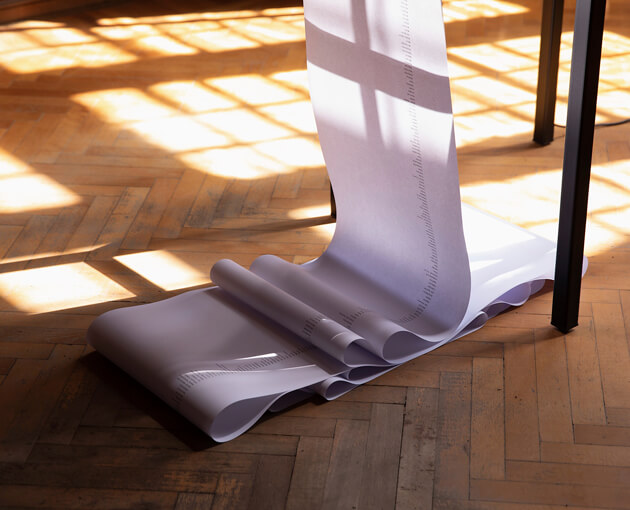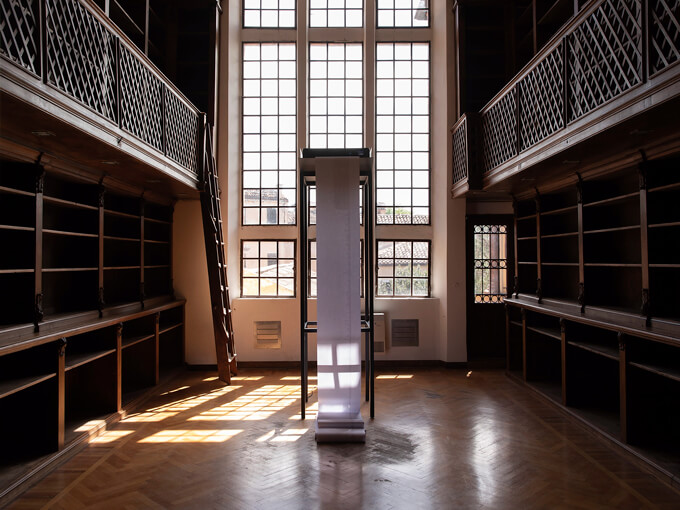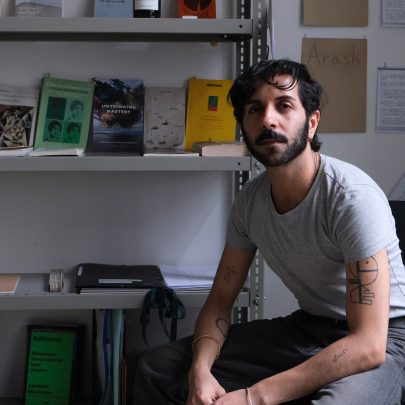Aug 8, 2019 Art
In disseminating a list of things lost, Dane Mitchell’s Venice Biennale exhibition is a homespun act of resistance.
Venice’s central mystery is that it exists at all, but it may not for much longer. The most singularly wondrous expression of humanity’s textural, sensual and spiritual potentials will likely disappear, eventually, under rising tides attributable to another, completely human-made creation: climate change. And yet despite being on its last legs, Venice still resists the contemporary urge to control and know everything about it. It’s impossible not to get lost there, no matter how well you know it; even the Sauron-eye of Google Maps glitches in its alleyways. But in the end it will go, and we will be entirely responsible for its destruction.
The depressing truth at the heart of Dane Mitchell’s excellent exhibition Post hoc, New Zealand’s official presentation at this year’s Venice Biennale, is that when Venice sinks, nothing at the macro level will change — because despite constant processes of erasure, extinction and loss, the weight of the world never really shifts; matter just transforms. Mitchell’s fascination with this material conundrum is at the heart of Post hoc: a project generated by loss, not as an idea but as an actuality. At its core is a massive list, assembled by the artist and his assistants, running to more than two million items, of things that have disappeared from our world. The list is so big that to hear the whole thing being read at a rate of eight hours a day would take seven months — the duration of this year’s Venice Biennale.
Some of the subgroupings from the larger list memorialise obvious extinctions: dinosaurs; long-gone volcanoes; burned books; lost cities. Others, though, are more abstract and even esoteric: objects of lost provenance; names given to the wind; lost poems. Many deal with natural phenomena that have left their traces on the physical world, including heat waves, retreating glaciers, floods and typhoons. It’s a seemingly endless, and arguably pointless, attempt to map what has been, in an age when Google has largely achieved what the Enlightenment set out to do — to make the entire world and all the knowledges it contains accessible. In the age of Search, Mitchell’s undertaking is perversely homespun: a gentle act of subjective resistance against surveillance capitalism’s algorithmic ubiquity.
Mitchell made his name in New Zealand in the late 90s, as a young artist working in a field of provocative art-world conceptualism that bordered on smart-arsery: vinyl recordings of prank calls to art gallery directors; going through the rubbish bins of prominent Auckland art dealers. He achieved a brief but very public notoriety in 2009, when he won a national art award for an artwork that was, ostensibly, a pile of art-trash, which sent pundits like Paul Henry apoplectic. Well before that, though, his insider hijinks had morphed into his Dust Archive, which he began in 2003. Mitchell would collect dust samples from international galleries and museums, grow bacteria from the samples, then photograph and exhibit the results. It was his take on “institutional critique”: measuring spaces not by what gets shown in them, but by the dirt and microbes that accumulate in their overlooked corners — invisible filth that inevitably includes particles of us.
That work evolved into a larger concern with the potential of unseen forces as sculptural mediums: not just the microbial and microscopic, but esoteric energies too. Mitchell developed a braided strategy that brought together spiritualism — in the true occult sense of ghosts and spellcasting — with scent and memory, into a counter-monumentalism that relied on conceptual art practices and a kind of “Emperor’s New Clothes” leap of faith by his audiences: a belief that a sculpture was there, even if it couldn’t be seen or held or touched. Perfumes, in particular, operated as a kind of haunting in his work. In Mitchell’s words, the perfumes he and his collaborators made — among them the smell of rain, and the smell of an empty space — became sculptures that formed in the brain, as their molecules were ingested into the body.

Containers, and containment, became the essential parameters for encounters with his invisible materials — handblown glass vessels that contained the exhaled speech of their blowers; vaporisers; fencing that created the permeable boundaries for a witch’s spell. But containers also created a problem for him. Often, they were just too beautiful, too refined, and this hyper-aestheticisation smoothed over the jagged quality and integrity of his ideas. This reached its peak in Iris, Iris, Iris at Auckland Art Gallery and Tokyo’s Mori Art Museum last year: a project about scent and colour, filled with brass surfaces, spotless glass, and giant incense-sticks in a deep and thoroughly Instagram-able blue.
Happily, Post hoc is Mitchell returning to his best: an exhibition with all the precision and clarity of his smartest work, and little of the elegant over-fussing. Its main base is Venice’s Palazzina Canonica, which was the historic home, until recently, of Italy’s Institute of Marine Sciences. Conceptually, there are tenuous links here to Mitchell’s lists, given part of the Institute’s responsibility is to research extinct or seemingly invisible marine life. Pragmatically, it’s a dream venue, on one of the main thoroughfares between the Venice Biennale’s two major venues, the Giardini and the Arsenale.
Post hoc’s heart — what curator Zara Stanhope describes as “the project’s engine” — is a big, tapered, anechoic chamber in one of the Palazzina’s out-buildings: an industrial object designed to measure the quality and range of electromagnetic transmission. Mitchell’s chamber is lined on the inside with hundreds of acoustic foam pyramids, like the teeth of a prehistoric monster. Those pyramids, combined with the chamber’s tapered shape, create an infinite horizon totally devoid of reverberation. At the centre of the chamber is a single speaker, through which a computer-generated voice known as Amy steadily incants Mitchell’s lists of lost things into a microphone.
It’s a container like Mitchell has never built before: one where its form necessarily follows its acoustic function, and one which sits heavily, even clunkily in place, its big vault-like door thick with rivets and its locking handle thunked shut. Mitchell has also designed a thin viewing window into it, to reveal the absent “Amy” inside, present via the speaker, reading into the mic. It’s like the quarantine window of an infectious-diseases ward, designed for hermetically sealed observation.
This idea of infection — or contagion — is, in fact, crucial to Post hoc’s agenda: information leaches out of the chamber and into the world not so much as sound, but as data. Inside the Palazzina itself, the Institute’s library has been completely emptied except for a printer, which simultaneously prints out Amy’s broadcast as it’s read in the chamber, each line like a single exhalation. The lists are also broadcast from Post hoc’s other key forms: a series of cell towers designed to look like pine trees. Like the chamber, these are industrially produced objects, used commercially around the world to create discreet networks that supposedly blend in with the natural environment. Up close, of course, they aren’t discreet at all: they’re obvious fakes, and Mitchell doesn’t want to hide the fact, particularly at the Palazzina, where three of them huddle like unholy techno-offspring under a much larger, real tree in the building’s grounds.
Within a certain range of the trees, visitors can connect their own devices and download Amy’s disembodied voice. This act of connection, though, knocks out the device’s 4G connection. The transaction — the infection — therefore becomes one-to-one, as Mitchell’s lists of the dead and disappeared spread into your smartphone. His trees are active transmitters — ambiguous agents of informational spread, in an age in which we fear biological contagion deeply, but also talk about “going viral” as a measure of success.
Mitchell’s work isn’t often overtly political, but there’s plenty here to suggest a subtle critique of our present-day digital madness. In one of several perceptive essays in Post hoc’s accompanying book, University of Auckland academic Stephen Turner also reads into Mitchell’s cell towers a postcolonial angle, seeing them in the context of New Zealand’s timber industry, and its “frankenpines”. Turner argues convincingly that both our fast-growing pine forests and our communications technologies, from telegraph wires to today’s cell towers, are part of a settler-colonial drive to create “place” by overwriting what was there before. Turner recasts Mitchell’s broadcasting pines as uncomfortable monuments to Pakeha claims of land ownership.
Mitchell has dotted cell towers around Venice with similar depths of conceptual and political consideration. The closest to his main venue is in a Park of Remembrance, a perfect location for a fake tree to broadcast lists of lost things. Another is at the far end of the Arsenale, the city’s historic ship-building yards and one of the Biennale’s main venues: on a patch of grass few people visit, Mitchell’s lonely tree stands ready to speak of loss to anyone kind enough to pause and listen. Another is in the city’s major architectural school, a repository for deep knowledge of Venice’s infrastructural past. And the final one is in a peaceful courtyard of the city’s main hospital, not far from the psych ward. Hospitals are spaces of healing, but of loss and death too. There’s also a subtle mania to Mitchell’s ludicrous lists, downloadable from a cartoonish tree, which, in the hospital grounds, is guarded by a vaguely surreal phalanx of local cats.
It’s said we’re living through earth’s sixth mass extinction; the difference from the other five is that this one is all our fault. The massive loss of biodiversity began as soon as we invented agriculture, and has accelerated obscenely in the industrial era. The best term we have for this is the “Anthropocene”: the period in which humans finally conquered nature, began to shape it around our material needs and self-image, and consequently destroyed the planet’s balance.

What we lost in diversity, we gained in knowledge: our ability to control the world unfolded alongside our correlate ability to order the information we acquired about it. Language, and its recording and storage, became the essential tools through which that information was accumulated. If this all seems obvious in retrospect, it’s nonetheless worth reflecting on, because we now stand at the end of that process. “Search” — the world’s information at our digital fingertips — has conquered the world. It’s the ultimate expression of the Anthropocene, and the final culmination of an intellectual process that began with the Enlightenment and its desire to eliminate mystery and belief.
The Romantics kicked against the Enlightenment’s organisational rigidities: like Mitchell, they wanted to raise and praise the dead, and make sure that scientific progress didn’t erase all the ghosts. Nature was where they sought their primal escape, in the sublime unknowability of a vast mountain rage, or a storm-surged sea, or in sex, with its apocalyptic and intimate release. But Search has put an end to all that. We can measure the height of Everest to the centimetre. We know how the weather works. We can biologically explain orgasm and watch it endlessly online. We have tamed it all.
Sublime experience — if we define this as an encounter with the immeasurable — now belongs not to nature but to things we have made: things that, in theories of the Anthropocene, are “hyperobjects”, forces so large and pervasive we struggle to contemplate them or see their edges. The three biggest and most forceful are extraordinarily recent, when measured in either human or geological time: capitalism, climate change, and the internet, and we are now on a tipping point — the moment in which these things we have made and unleashed are reshaping the world in ways we no longer control.
This is where Post hoc gains its real significance. Mitchell has created not just one, but two hyperobjects: first, the list itself, which can grow indefinitely and will likely accelerate, if our current attitudes towards technological obsolescence and the environment are anything to go by. But the paradox of Post hoc — its defining problem — is that its heaviest, most lumpen form, the anechoic chamber, is a kind of hyperobject too. This seems, at first, a contradiction, because it so obviously has its own edges and corners, riveted tightly shut. Inside, though, it’s a completely different story: a horizonless space that information can pass through and around, never bouncing or reverberating, forever. It’s a superb visual metaphor for the incomprehensibility of the force information now exerts on, and over, our lives.
It also feels like the perfect culmination of 15 years of Mitchell’s work. All that time, it seems, he’s been trying to find the pressure point inside his containers where matter, meaning and form fuse into a single entity. He’s finally found that point — he’s just had to get a bit ugly to do it. It also seems important that he’s moved away from the microbial and the olfactory to get there. Dust and perfume molecules are, in the end, still physical matter, no matter how small. But data? We still don’t really know what it is, where it exists, or what it’s doing to us.
And it’s significant Mitchell has achieved all this in Venice. Not because of international art-world kudos, or the implicit relief that he hasn’t wasted such a big opportunity (though both of these things are relevant), but because the fusion of matter, meaning and form is precisely what makes the city itself so important. The incommensurability of Venice’s present lies in the way it co-exists with its past, and this step out of conventional linear time is embedded in every false turn, hidden church and dead end. Post hoc is a tribute to that mystery, and a rallying cry to preserve belief, magic, and the ghosts that made us.
This piece originally appeared in the July-August 2019 issue of Metro magazine, with the headline “The Weight of the World”






